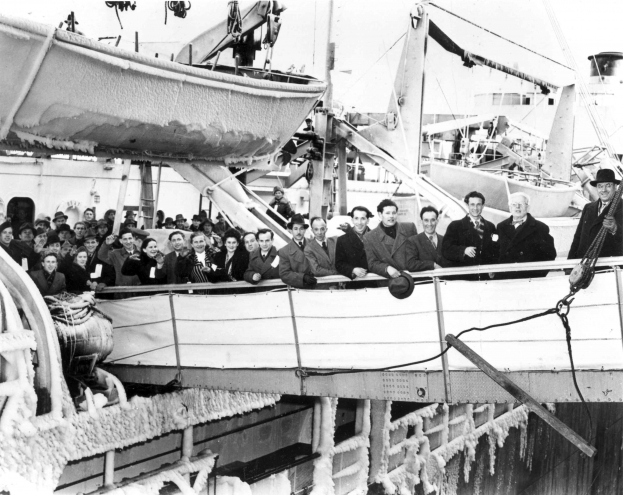Immigration
Jewish immigration to Ontario began in the early 1800s when it is best described as a trickle. Most of the earliest immigrants were from Britain or Germany and often arrived via the United States, only staying in Ontario a short time before moving on. The first permanent Jewish resident of Toronto was Judah Joseph who arrived in 1838. Joseph came from Britain via the United States, first to Hamilton, Ontario and then to Toronto.
By 1871, there were still only 528 Jews in Ontario, with Toronto and Hamilton accounting for over half of this number. However, the number of immigrants and their countries of origin began to change in the 1880s with a surge in Yiddish speaking immigrants from eastern Europe. In what would become a pattern, they came to Canada looking for a better life, fleeing poverty, economic depression, and religious oppression. While the majority settled in existing Jewish communities like Toronto and Montreal, others in Ontario settled in smaller towns throughout the province, often becoming storekeepers.
In the early twentieth century, another wave of immigrants came to Canada and Ontario. From 1901 to 1927, the Jewish population of Canada grew from under 17,000 to 125,000, with Ontario and Quebec each having close to 50,000 Jewish residents. As before, most new immigrants settled in larger cities with established Jewish communities. For example, by 1931, about seventy per cent of all Jews in Ontario lived in Toronto. However, many immigrants did move to towns and villages throughout Ontario, even the more remote northern towns. It was very common to find a few (or more) Jewish families in towns of any size.
After 1927, Jewish immigration to Canada came to a near halt with new restrictive immigration laws. These laws affected all applicants but especially the great number of eastern European Jews trying to escape increasing antisemitism. The government did not change its policy during the 1930s in spite of the increasing knowledge of the plight of Jews in Europe. While these laws were partly the result of the depressed economy in Canada, they also reflected the antisemitic attitude of some key politicians of the day.
In the years 1933-1939, immediately prior to the Second World War, Canada accepted fewer than 150,000 immigrants of which only 5,000 were Jewish. This was much less than the number admitted by other countries such as Australia, Brazil, Argentina, and the United States. During this time the Jewish Immigrant Aid Services of Canada (JIAS), which was established in the early 1920s, continued its efforts to lobby the government while directly assisting Jewish immigrants.
With the end of the war, Canada's policy changed and from 1947–1950 a large wave of immigrants came to Canada. Close to 100,000 displaced persons—many of them Jewish Holocaust survivors—were admitted. Most were aided in their transition to Canada by a number of organizations and agencies such as JIAS, JVS (Jewish Vocational Services), and JF&CS (Jewish Family and Child). Many were brought in through immigration projects targeting specific trades and occupations such as tailors and farmers.
The 1960s and 1970s saw immigration to Ontario from new sources including Quebec, northern and southern Africa, and the former Soviet Union. In the case of Quebec and southern Africa, the primary cause was not poverty or religious oppression as it had been with the older eastern European immigration; instead, the cause was future political uncertainty. In Quebec, the growth of pro-separatist sentiment and the election of a separatist government in 1976 resulted in fear that the province would leave Canada. Consequently, many of Quebec’s federalist, English-speaking Jews (and others) moved to Ontario. Partly because of this and other immigration trends, Toronto replaced Montreal as having Canada’s largest Jewish population. Jewish immigration from southern Africa to Ontario also began in the 1970s in order to escape from increasing crime and violence and political uncertainty.
Conditions for Jews in North African Arab countries worsened after the creation of Israel in 1948 and especially following the Six-Day War. Many left for Israel, Europe, and elsewhere, including Canada, where the majority of French-speaking Moroccans settled in Montreal. Other North African Jews came to Ontario, increasing the city’s Sephardic Jewish population.
The single largest group of immigrants to Ontario during this period was from the Soviet Union. During the 1970s, Soviet Jews were persecuted and denied permission to emigrate, resulting in the term refusnik. In the 1980s, after many years of political pressure from governments and Jewish organizations around the world, the Soviet Union eased its restrictive rules on Jewish emigration. Large numbers of Jews left for Israel, the United States, Canada, and Europe. The majority who came to Canada settled in Ontario and especially Toronto. A large scale effort was made to assist the Soviet immigrants through JIAS and other Jewish organizations.
Today, Ontario continues to draw a steady flow of Jewish immigrants from many countries, including Israel. In recent years, Toronto alone has absorbed more than half the Jewish immigrants to Canada, with others going to Ottawa, Hamilton, and other Ontario cities.
